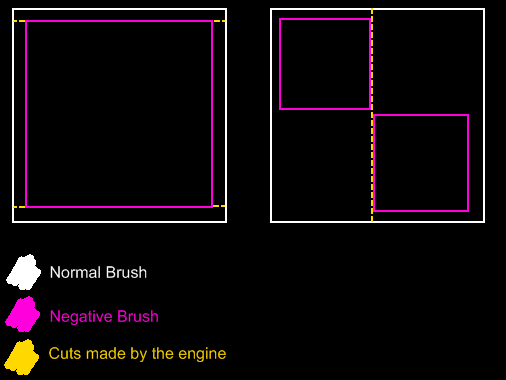QuArK Subtractive Space
Using QuArK as a Subtractive Editor
This method is inspired by a tutorial I can't find today, written by a fellow nicknamed Hardcoal.
Trying to adapt to Quake editors when you're used to UnrealEd is made very difficult by the inverted paradigm of additive or subtractive space. In Quake, the world is empty and the level-designer has to add solid blocks as floor, walls and ceilings, whereas in Unreal, the world is full and the designer has to subtract empty volumes inside it. Having to learn how to use a new software is hard in itself, but having to adapt to a completely different philosophy makes it even harder. So here is how to use UnrealEd-Style subtractive space to design levels for Quake.
This trick can only be done with QuArK. This editor features brush-modifiers known as duplicators, whose role is not only to duplicate geometry but also create patterns or mirror entire parts of a map. One interesting features is the presence of digger brushes and negative brushes. These are just what their names suggest: space-carving objects. These can be used to achieve UnrealEd-like mapping.
You will need a big brush to carve your map out of. Negative brushes can only affect other brushes if they are in the same group, so in most cases you will have a big group containing both your giant origin cube and a group of negative brushes. To simulate additive brushes, you will need a third group of brushes containing normal brushes. The result would look somewhat like this:

The World group contains two groups: Solid Space, a group whose flags (seen by clicking RMB on the group) are "Hidden in textured view", "Cannot select with the mouse", and "Group is grayed out". This means you will not see or select it while mapping. It contains only one big brush, Origin Brush, the massive solid block in which the map is going to be carved out. World also contains Subtracted Space, whose flags are default, but with the "Negative" specific (the second icon from the left, just above the tree-view, opens the specific/args window for currently selected group/brush). This group contains every subtractive cube. Beside World is another group, completely normal, Solid Details. These are normal additive brushes. I only changed the group colour to yellow in order to have a good contrast between subtracted brushes and added brushes, as negative brushes appear purple in the wireframe viewports.
With this organisation, however, you cannot use a brush in Subtracted Space to carve volumes out of brushes in Solid Details. To do that, I suggest creating a last group inside Solid Details, in which to place brushes with the individual specific "neg". With that in mind, you can create complete maps from subtracted space, just like in UnrealEd. However, there are a few problems I have to discuss:
First, the .map file will be horrible. Instead, consider releasing the .qkm or .qrk file for QuArK users to take a look. Finally, there are limitations because of the way QuArK emulates subtractive brushes. Two coplanar faces, even completely separated, will share one texture, no matter what you do. Consider a slight difference in alignement if you need a different texture on one surface. These two problems are a result of the way QuArK splits the Origin Brush to create empty space:

The engine splits the brush along the edge of a brush. If another brush has a coplanar face, the coplanar surface will actually be the extension of the first subtracted brush's side, with its texture and any other setting. Exact information on how this works can be found on this page of the QuArK infobase.
Moreover, if the Origin brush is too large, the builder will issue a warning. If you have troubles building the map, consider shrinking it before trying anything else.
Very sharp angles might create small holes, but this is easily fixed with the help of a few more brushes. The hole can also be filled with a solid brush. Finally, negative brushes are not displayed in "textured" and "solid-colour" modes if they are not selected. This will force you to use the powerful tag/wrap from tag feature of QuArK. Group selection is very useful and will let you see only the part of the map you are working on.
Another way to use this is to create the map as a series of hollowed out modules. This will prevent the .map file from being too messy. By using one block per part of the map, less useless polygons will be produced and the negative brushes will interfere with each other less frequently. However, it might make mapping tedious as it will require a few more steps for each section of the map.
I highly suggest peering over the QuArK infobase to learn more about negative brushes and all the powerfull tools this editor features.
 RSS Feed
RSS Feed Index
Index